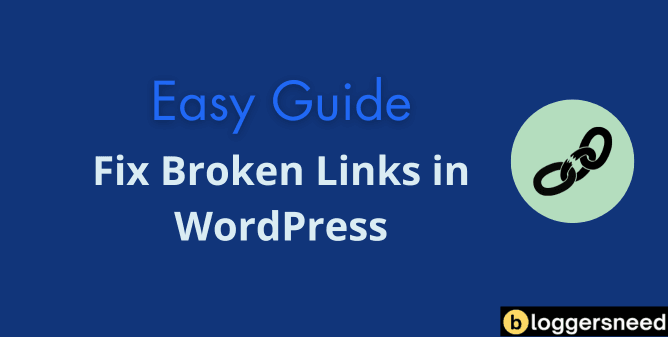
Broken links cause a significant threat to both your website’s SEO performance and visitor satisfaction, creating frustrating dead ends throughout your content.
These errors typically surface when pages get deleted, URLs contain typos, or external content undergoes changes.
Several tools can help detect dead links, from comprehensive platforms like Ahrefs and SEMrush to specialized crawlers like Screaming Frog and Google Search Console.
After identifying broken links, you have multiple options: implementing 301 redirects, correcting URL errors, or simply removing dead links altogether.
Although fixing broken links is a simple process, doing it without proper guidance can cause serious issues and affect SEO rankings. We’ve crafted a comprehensive guide to help you check, find, and fix dead links to improve your SEO performance.
Table of Contents
What Are Broken Links?
Broken links (404 errors), also known as dead links, occur when pages are moved or deleted without proper redirects. These issues can arise from mistyped URLs during content creation, external websites changing their structure, or linked sites going offline. Website migrations, CMS updates, and domain name changes can also transform working links into broken ones, affecting your site’s user experience and SEO performance.
How Broken Links Occur on a Website?
Broken links appear when website pathways fail to reach their destination pages. The causes behind these failures are diverse: third-party websites may shut down unexpectedly, pages might be deleted without updating their references, URLs could contain typing mistakes.
Website restoration often breaks links, especially during domain migrations or page renaming without proper guidance.
External websites can disappear or reorganize their content, breaking your outbound links even when your internal links remain intact.
Content creators occasionally introduce broken links through simple URL typos during the publishing process.
Though typically temporary, server-side issues can also disrupt link functionality until normal operations resume.
How Do Broken Links Affect SEO?
Your website’s broken links can seriously damage your SEO performance by frustrating visitors and increasing bounce rates when they can’t access the content they want.
Search engines like Google interpret these dead ends as signs of poor site maintenance and outdated content, which can lower your rankings in search results.
Beyond rankings, broken links waste your valuable “crawl budget” as search engines spend time trying to access non-existent pages instead of indexing your active content.
Impact on User Experience
Dead-end links frustrate visitors and shatter trust in your website, often causing them to leave within moments after seeing your website.
Such disruptions not only increase bounce rates but also nullify sale conversions, as users lose patience with navigation failures.
Your brand’s reputation depends on reliable content delivery, when visitors consistently encounter broken pathways, they’ll likely visit out your competitors website instead.
The ripple effects extend beyond immediate abandonment, as these negative encounters discourage future visits and compromise your website’s long-term viability.
Effect on Search Engine Rankings
Search engines have become increasingly sophisticated, yet they continue to depend on functional links to effectively map and understand websites. When your site contains broken links, it disrupts the engine’s ability to properly analyze and categorize your content, potentially diminishing your visibility in search results.
Poor site maintenance, evidenced by broken links, depletes your crawl budget and sends negative signals to search algorithms.
The impact becomes particularly severe when these broken links exist within critical areas like navigation menus or key content sections, often leading to unpredictable fluctuations in search rankings.
Your site’s authority also suffers when external websites link to pages that no longer exist on your domain, resulting in missed opportunities to strengthen your position in search results through valuable ranking signals.
How Do Broken Links Hurt SEO?
When your website contains broken links, search engine crawlers will encounter errors that prevent them from properly indexing your content.
You’ll see these problems show up as crawl errors in tools like Google Search Console, indicating that search engines can’t efficiently navigate and understand your site’s structure.
Additionally, broken links disrupt the flow of link equity throughout your site, weakening the overall authority that helps pages rank in search results.
Increase in Crawl Errors
Broken links cause a significant obstacle for search engine crawlers as they map and catalog your website’s content. When these digital pathways lead nowhere, search engines typically respond by scaling back how frequently they scan your pages, creating delays in getting fresh content indexed.
Crawl errors, such as 404s highlighted in Google Search Console’s coverage reports, indicate poor site maintenance and hinder bot navigation, revealing critical accessibility issues.
Each broken link forces search engines to waste valuable resources attempting to reach non-existent pages, and this inefficiency takes a toll on both your crawl budget and overall indexing performance.
Negative Effects on Link Equity
Broken links do more than just create navigation problems – they actively erode your site’s link equity, which is the SEO value transmitted between pages through hyperlinks.
When these connections break down, they disrupt the natural circulation of authority and ranking power throughout your website’s structure.
Internal broken links create dead ends that block PageRank from properly distributing across your pages, while broken external links dilutes precious backlink authority that could be boosting your rankings.
The damage isn’t isolated – it ripples through your entire site hierarchy.
As link equity diminishes, it weakens not just the affected page but compromises the effectiveness of your broader link-building strategy and overall SEO efforts.
How to Check Broken Links on a Website?
You’ll find two main methods to track down broken links on your website: manual checking and automated tools.
Manual checking involves clicking through links one by one, which works for small sites but becomes impractical as your content grows.
For larger websites, you’re better off using specialized broken link checker tools that can scan hundreds or thousands of URLs automatically, saving you significant time while providing detailed reports of any issues found.
Using Manual Methods for Identifying Broken Links
Want to find broken links without special tools? Start by methodically clicking every link on your site, documenting any that trigger error messages or dead ends.
Your web browser already includes valuable diagnostic features – a simple right-click and “Inspect Element” selection reveals the status codes for each link. Additionally, your web server’s error logs can highlight patterns of 404s and other link failures.
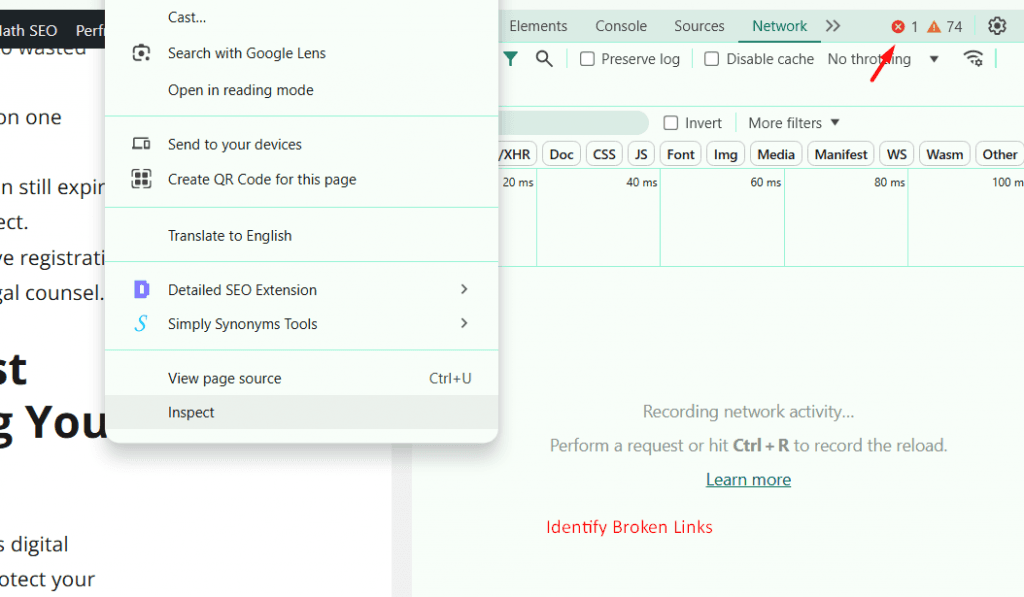
For smaller websites or when examining specific areas, these hands-on approaches prove invaluable despite their time investment.
Beyond mere identification, manual testing provides crucial insights into how broken links affect visitor navigation and overall site usability.
Using Automating Broken Link Detection Tools
Manual link checking is useful for smaller websites, but when dealing with sites containing thousands of pages, automated tools become essential.
By leveraging specialized software, webmasters can identify connectivity problems across their entire domain within minutes, transforming what would normally be an exhausting manual process.
Several industry-leading platforms excel at comprehensive link analysis – Ahrefs, SEMrush and Screaming Frog stand out among them. Their sophisticated crawling mechanisms detect not only broken links but also reveal HTTP status codes and track both internal and external redirects.
The detailed reports generated by these tools can be conveniently exported to spreadsheets, enabling systematic organization of required fixes.
Beyond one-time scans, most platforms feature automated scheduling capabilities, empowering teams to maintain consistent link monitoring and address issues before they compromise user experience or site performance.
How to Find Broken Links With Ahrefs?
Ahrefs is the best SEO tool with helpful features and one of the key features is identifying outgoing and internal broken links.
To find outgoing dead links, go to Site Explorer, enter your website, and click Search. Within seconds, it will display site traffic and backlink details. Under Outgoing Links, click Broken Links to view the results.
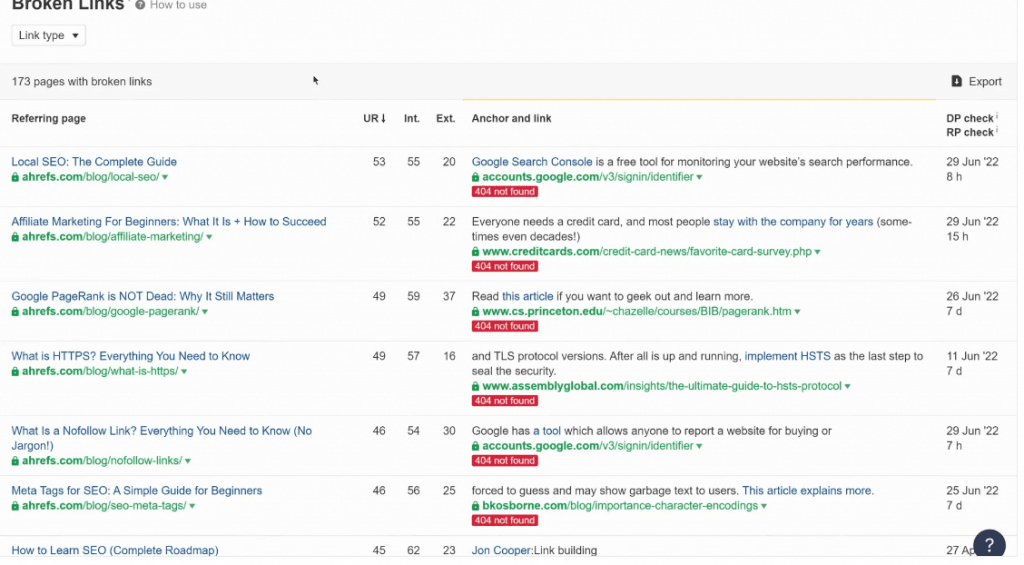
To find internal broken links, connect your Google Search Console account to Ahrefs and run a site audit.
After completing the site audit, click “All Issues” to identify website problems and locate broken links in the link section.
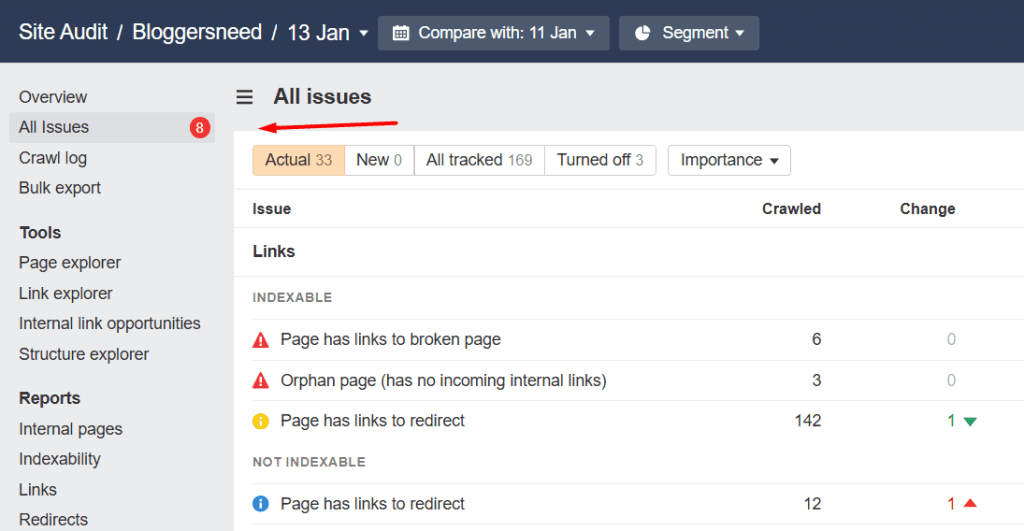
After finding dead links in your WordPress website through Ahrefs site audit report, export the data and either remove the links or implement 301 or 302 redirects to appropriate pages.
How to Find Broken Links With Semrush?
You’ll find Semrush’s broken link checker under the Site Audit tool, where you can quickly set up a crawl of your website to identify problematic URLs.
After running the audit, you can access detailed reports showing all broken links, including both internal and external URLs that return 404 errors or other HTTP status codes.
The reports let you export your findings and prioritize fixes based on factors like traffic impact and crawl depth, making it easier to tackle the most critical issues first.
Setting Up a Site Audit for Broken Links
Semrush’s Site Audit tool simplifies the time consuming task of tracking down broken links across your website one by one. Getting started requires creating a fresh project within the Site Audit section of your dashboard. The initial setup involves a few essential configurations, including defining your crawl boundaries and limitations.
Within the audit interface, you’ll find the “Crawl” feature, where you can fine-tune various parameters. These settings let you adjust everything from scan depth to URL exclusions, while controlling the speed at which the tool examines your site.
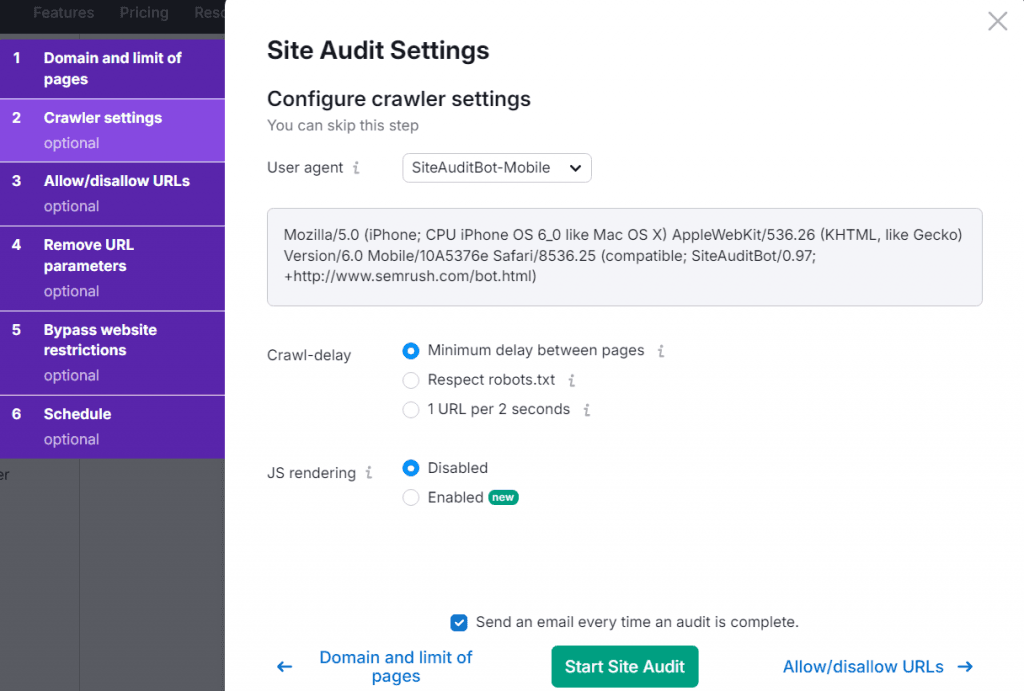
As it works, the system thoroughly examines both internal pathways and external connections, pinpointing 404 errors alongside other link-related problems.
After launching the scan, Semrush takes over, methodically analyzing your site’s link structure. The resulting comprehensive report maps out every broken link discovered, enabling you to tackle repairs strategically based on each issue’s severity and overall website impact.
Interpreting Semrush Reports
Semrush’s Site Audit report divides broken link data into three distinct sections.
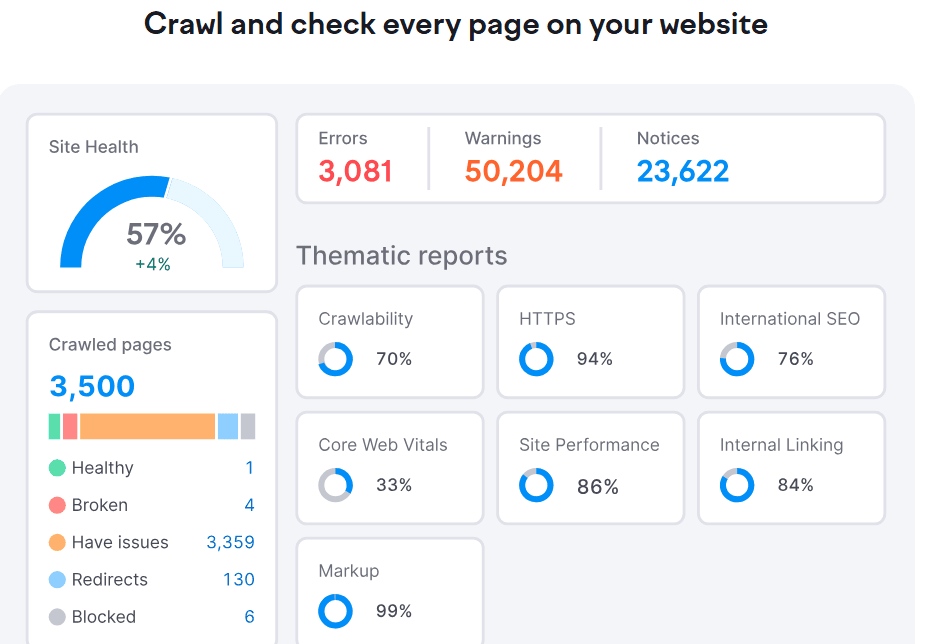
You’ll find internal and external broken links with HTTP status codes in the primary section, while crawlability obstacles blocking search engine access appear in the second. Any broken images or resource files are consolidated in the final section.
To effectively analyze broken links, take advantage of Semrush’s detailed metrics including crawl depth, page referrals, and target URL statuses.
The impact of each broken link varies based on factors like incoming link volume and placement within your site hierarchy.
Broken links on high-traffic pages or those crucial to conversions deserve immediate attention, as they can significantly diminish both user experience and revenue potential.
How to Find Broken Links in Screaming Frog?
To effectively find broken links in Screaming Frog for WordPress sites, you’ll need to configure the crawler settings to match your site’s structure and set appropriate crawl limits.
You can initiate the scan by entering your website’s URL and letting Screaming Frog crawl through your pages, identifying any 404 errors or other link issues.
Once the crawl is complete, you’ll find thorough broken link data in the “Response Codes” tab, where you can analyze and export the results for further action.
Configuring Screaming Frog for WordPress Sites
When crawling WordPress sites with Screaming Frog, proper configuration is important for meaningful results.
Begin with the fundamentals: adjust your crawl depth and throttle the scanning speed to maintain server stability.
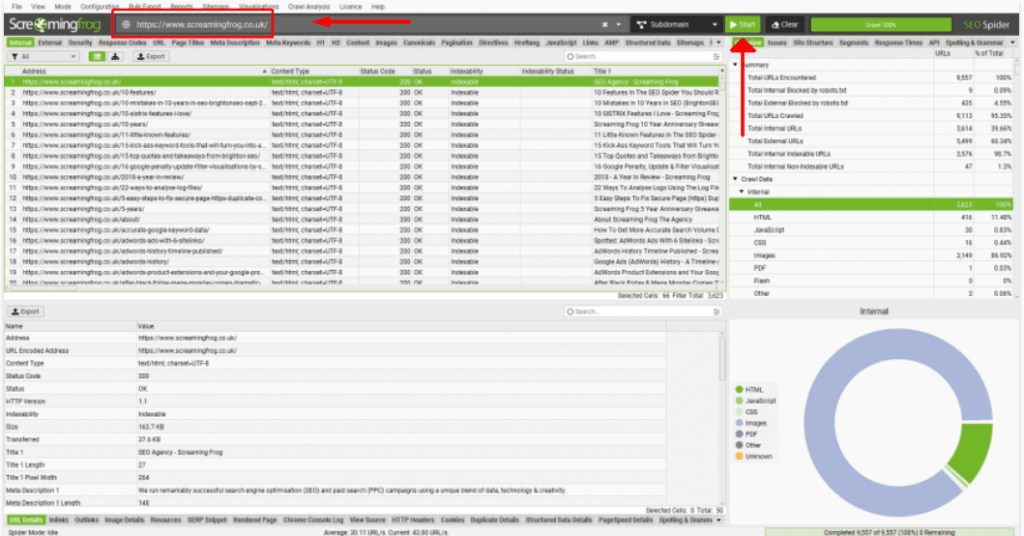
WordPress sites demand specific optimizations in Screaming Frog. Switch on the “Respect nofollow” setting and establish URL rewriting parameters that align with WordPress permalink patterns.
Custom search and replace filters help pinpoint platform-specific challenges that might otherwise go unnoticed.
Smart exclusion rules prove essential – particularly for wp-admin and wp-content directories, which typically yield unnecessary crawl data.
Round out your setup by customizing the user agent string for seamless site access. The “Check Images” functionality deserves special attention, as it reveals missing media assets across your WordPress content.
Analyzing Broken Link Data in Screaming Frog
Finding broken links in Screaming Frog requires just a few clicks – navigate to the “Response Codes” filter and choose “Client Error (4xx)” to uncover problematic URLs.
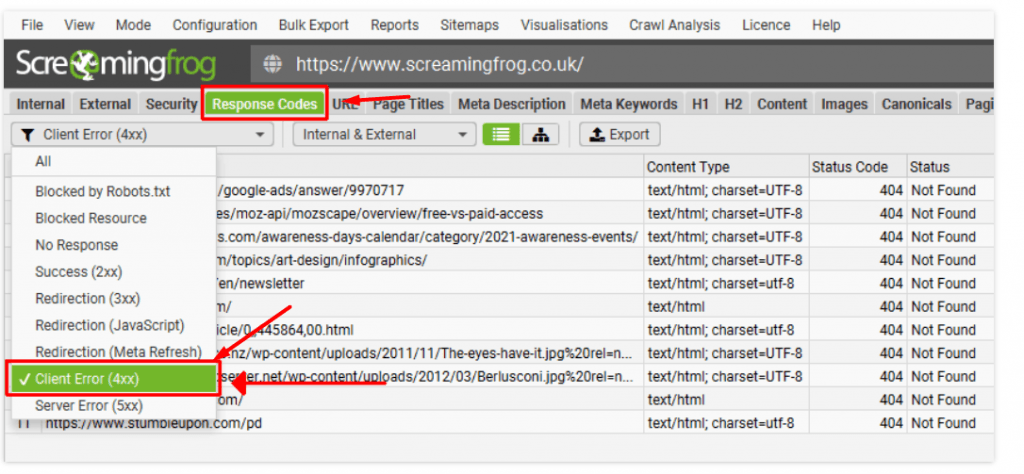
This view reveals pages returning 404 errors alongside other client-side issues across your website.
Need a comprehensive overview? Head to the “Bulk Export” menu and download the “Response Codes” report.
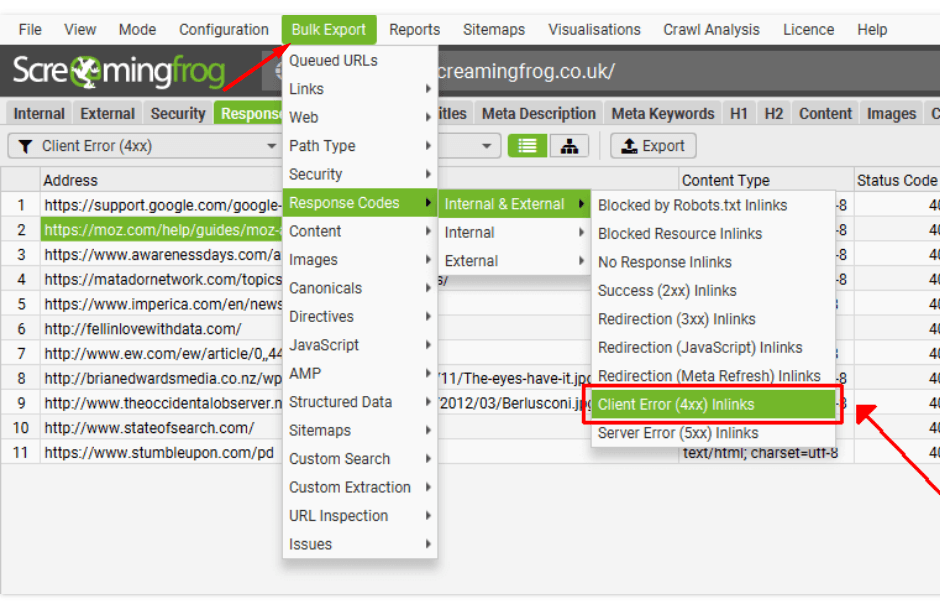
The resulting spreadsheet maps out each broken URL’s location, including its origin page and linked text. By gothrouing this data, you can spot troubling patterns, whether they’re structural URL issues or concentrated problem areas within specific site sections.
Start your fixes with the most critical pages – your homepage and main navigation deserve immediate attention, as these broken links have the greatest impact on user experience.
How Do I Check My Broken Links in Chrome?
You’ll find several helpful Chrome extensions that can scan your website for broken links quickly and efficiently.
Popular options like “Check My Links” and “Broken Link Checker” will highlight and display problematic URLs directly in your browser as you browse pages.
These extensions can save you significant time compared to manual link checking, letting you identify and fix broken links before they impact your site’s user experience.
Using Chrome Extensions to Find 404 Error Links
Chrome’s huge collection of link-checking extensions makes the tedious task of finding 404 links remarkably straightforward. While tools like “Check My Links” and “Broken Link Checker” lead the pack, each offers its own unique approach to identifying problematic URLs.
These powerful utilities instantly transform your browsing experience by color-coding links based on their status.
Getting started requires nothing more than a quick visit to the Chrome Web Store and a simple installation.
Once added to your browser, these tools starts to find broken links within a single click of their icon, methodically examining every link on your current page. As the scan progresses, you’ll watch in real-time as working links separate themselves from their broken counterparts.
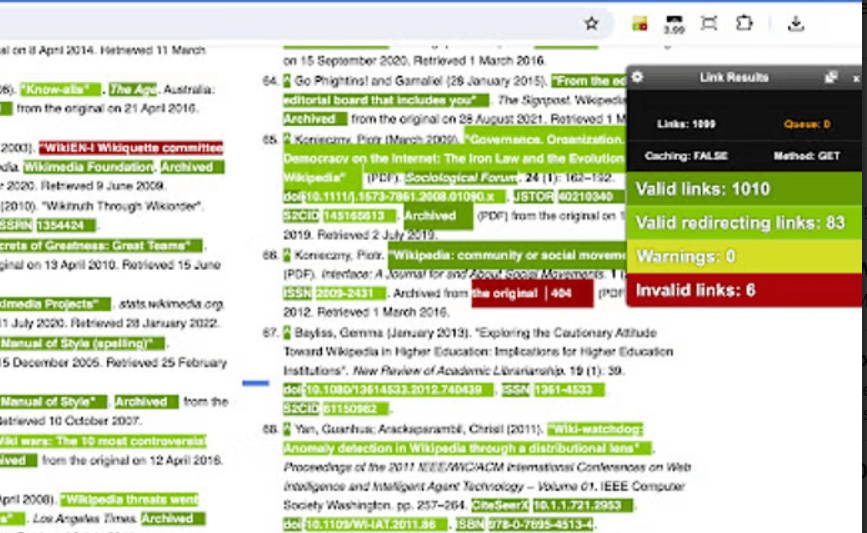
How to Fix Broken Links in WordPress?
You can fix broken links in WordPress by first regularly checking for and removing outdated content that’s no longer relevant or accessible.
Installing a redirection plugin like Redirection or 301 Redirects will help you properly handle deleted pages by automatically directing users to relevant alternative content.
For maximum effectiveness, you’ll want to combine both manual content cleanup and automated redirection management to maintain a healthy site structure and positive user experience.
Steps for Removing Outdated Content
Maintaining fresh content on WordPress website is to smart way to avoid broken links.
Use tool like Ahrefs to perform comprehensive content audit – this key first step reveals which pages have lost their relevance or stopped generating meaningful traffic.
Careful analysis of key metrics, including visitor data, bounce rates, and conversion statistics, will guide your decision-making.
After analysis proceed with the essential tasks that follows.
- Purging or refreshing dated posts and pages
- Eliminating non-functioning media and attachments
- Clearing out discontinued product listings
- Merging or storing duplicate content
- Revising internal link networks
- Maintaining records of removed URLs
Remember to establish a system for tracking these changes, as documentation proves invaluable for future site management and content strategy decisions.
After removing high-value pages, implement 301 redirects to avoid broken links while preserving traffic and rankings.
Redirection Plugins for Handling Deleted Links
WordPress users can protect their websites from broken links by installing a reliable redirection plugin. While Redirection and 301 Redirects stand out as popular choices, these tools eliminate the need for technical coding knowledge when implementing redirect strategies.
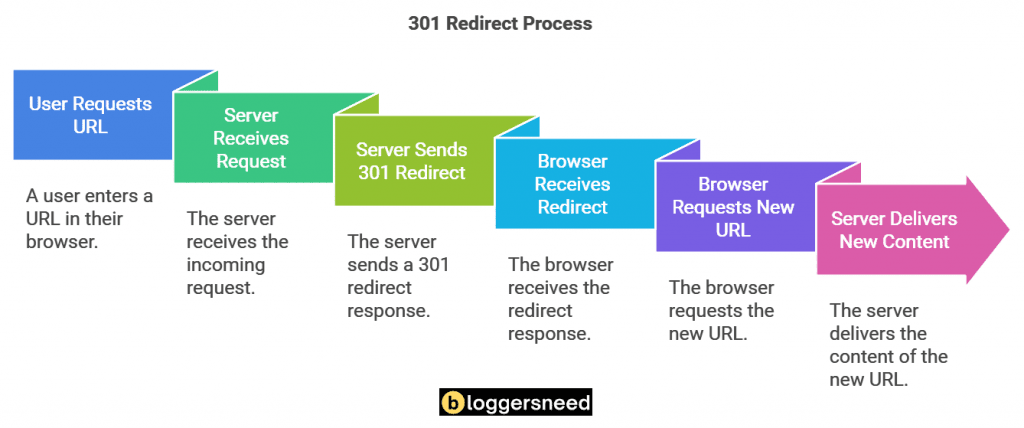
Using the plugin, simply track 404 errors and create new redirects through an intuitive interface – whether 301 or 302.
To effectively redirect broken links, utilize SEO plugins such as RankMath or Yoast SEO, which offer integrated redirection features for efficient website management.
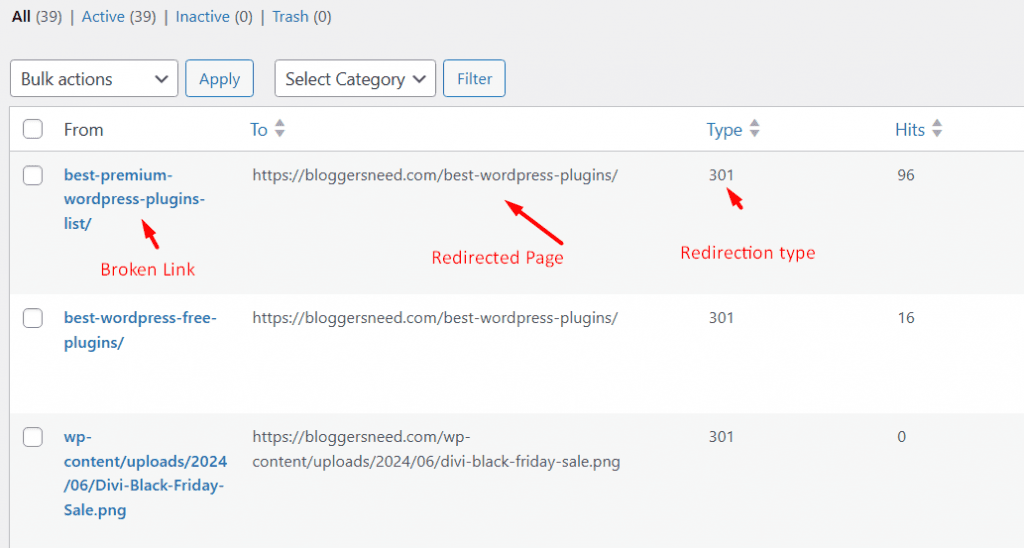
To maintain optimal performance, schedule regular audits of your redirect rules and adjust them according to changing needs.
Updating Internal Links
To effectively maintain internal links in WordPress, start with a comprehensive audit that identifies and resolves any broken connections in your site’s structure.
WordPress’s native link checker helps site owners identify broken links, but many prefer specialized internal link building plugins like Link Whisper or Broken Link Checker for efficient scanning and bulk editing, especially on larger sites.
When fixing 404 links, prioritize updating destination paths with meaningful anchor text that guides both visitors and search engines to relevant content.
Ensure your site’s internal links effectively directs users to intended destinations by thoroughly validating the accuracy and user experience of all fixed interlinks.
Fixing External Links Using Third-Party Tools
WordPress site owners have numerous plugin options for managing external links, with Broken Link Checker and Link Whisper standing out as powerful solutions that eliminate tedious manual checks.
These automated tools constantly monitor your website’s link health, transforming what was once a time-consuming task into a streamlined process.
The key features of these tools include bulk editing functions, redirect management, automated scanning schedules, Google search console integration, comprehensive reporting options and email alerts for link failures.
This strategic approach helps preserve both your site’s search engine rankings and visitor satisfaction.
How to Fix or Remove Broken Links (404 Errors) from Google Search Results?
You’ll need Google Search Console to track and identify broken links appearing in search results for your website.
Once you’ve found 404 links, you can request Google to remove outdated links through the “Removals” tool in Search Console.
You can also speed up the process by implementing proper HTTP status codes like 404 or 410 and submitting an updated sitemap to Google.
Using Google Search Console to Identify Issues
Do you need to find broken links that affect your website’s search performance?
Then start by submitting your website to Google search console.
Google Search Console provides a comprehensive solution that integrates seamlessly with Google Analytics, revealing exactly how these broken links affect your traffic patterns and user engagement.
The Coverage report serves as your central hub for discovering 404 errors and link-related problems. Make it a practice to systematically review these reports, focusing first on issues that most impact your site’s performance.
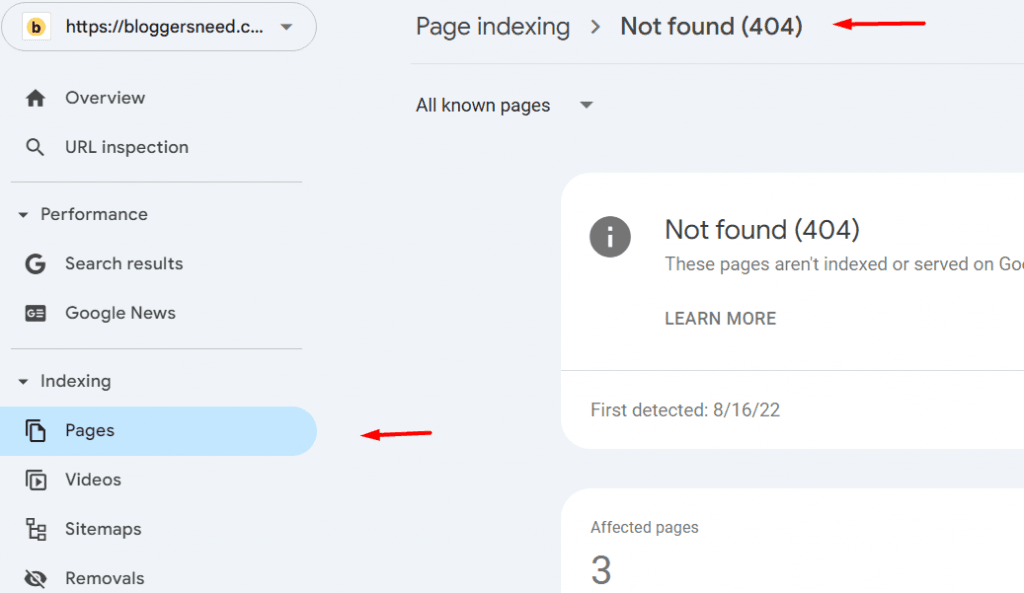
Within the Links section, you’ll find a detailed breakdown of both internal and external connections, making it easier to trace problematic links to their source.
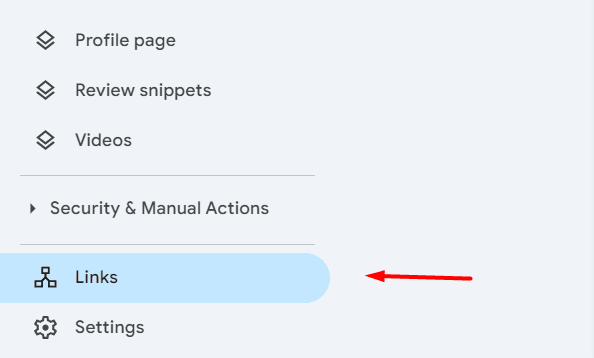
Regular monthly monitoring ensures your site maintains a strong link structure and avoids search engine penalties. This proactive link management preserves your site’s health and search visibility.
Requesting Link Removals and Corrections
When Search Console reveals broken links, addressing them requires careful coordination with the websites hosting these problematic URLs.
The process starts with contacting other bloggers by creating a clear, professional email template that details the needed changes.
Your outreach message should outline the specific 404 error links requiring attention while offering constructive solutions. Rather than simply pointing out errors, provide working alternatives or suggest relevant content updates that could serve as replacements for the dead links.
Essential elements to include in your communication:
- Precise URL location of the broken link
- Functional replacement link when possible
- Clear explanation of mutual benefits
- Complete contact details for future correspondence
Document all outreach attempts in a detailed spreadsheet, and send follow-up messages within 7-14 days after any unanswered initial contact.
This systematic approach helps maintain organized link-building efforts while maximizing the chances of successful corrections.
How to Fix Broken Links (404 Errors) in Shopify?
Broken links (404 Errors) in your Shopify store can be fixed using several effective methods. The platform’s built-in link management tools offer a simple way to identify and repair dead links across your site.
Start by examining URL handles for your products, collections, and pages within your Shopify themes settings. When content has been relocated or removed, set up 301 redirects from your admin panel’s Navigation section to guide customers toward relevant alternatives.
Maintaining external links requires periodic content audits with automated tools, followed by updates or removal of outdated connections. A thorough review should encompass navigation menus, footer sections, and product descriptions.
To enhance user experience, design a custom 404 error page that assists visitors in locating their desired content.
How to Find Broken Links in Selenium Python?
Selenium Python offers effective tools for detecting broken links during web automation testing. Before diving in, equip your environment with key dependencies: selenium-webdriver, requests, and beautifulsoup4.
The process involves several critical steps.
- Configure your WebDriver and launch the browser instance.
- Scan the webpage to gather all hyperlinks using driver.find_elements().
- Evaluate each URL’s health by examining HTTP response codes.
- Flag problematic links when encountering error codes like 404 or 500.
- Build robust exception management for network timeouts and malformed URLs.
- Optimize your link validation strategy with parallel processing techniques to accelerate the checking procedure.
- Strengthen your testing framework with sophisticated error handling mechanisms and comprehensive reporting features.
- Pay special attention to both internal navigation and external references, as each type carries distinct implications for your website’s search engine rankings.
FAQs About Broken Links (404 Errors)
Can Broken Links Negatively Impact My Website’s Bounce Rate?
Yes, Your website’s bounce rate will increase when visitors encounter broken links, creating a poor user experience that frustrates people and makes them leave your site immediately without exploring further.
How Long Does It Take Google to Recognize Fixed Broken Links?
You’ll typically see Google recognize your fixed links within a few days to 2 weeks. Link recognition time varies based on crawl frequency, while SEO indexing delays depend on your site’s authority.
Do Broken Links on Social Media Profiles Affect Website SEO?
Your social media profile links won’t directly impact your website’s SEO, but proper link maintenance across all platforms helps maintain user experience and brand credibility with both visitors and search engines.
Are There Any Benefits to Keeping Certain Broken Links Intentionally?
You shouldn’t keep broken links intentionally as they harm user experience and SEO. Even if you’re planning a strategic link shift, it’s better to implement proper redirects instead.
Can Broken Links in Email Newsletters Impact Website SEO Performance?
Your newsletter’s broken links won’t directly affect SEO, but they’ll harm your email engagement metrics and link tracking data, which can indirectly impact your overall digital marketing performance.
Do Implementing 301 Redirects Fix Broken Links?
Yes, implementing 301 redirects fixes broken links by permanently redirecting users and crawlers from the broken URL to a new, valid URL
Affiliate Disclosure: Some of the links in this post are affiliate links, which means I may earn a small commission if you make a purchase through those links. This comes at no extra cost to you. Thank you for your support!
